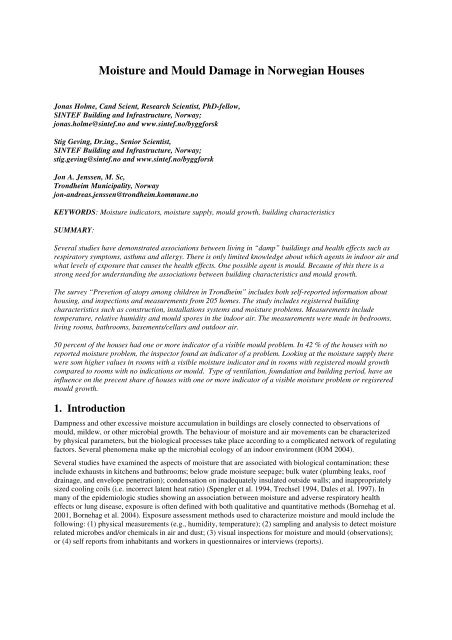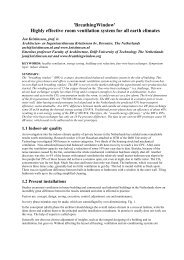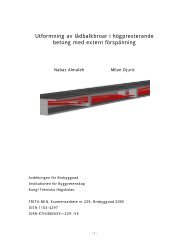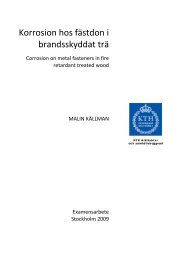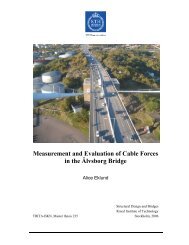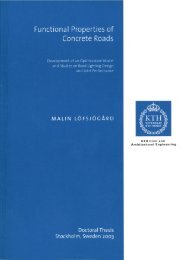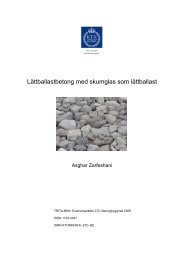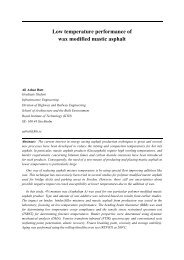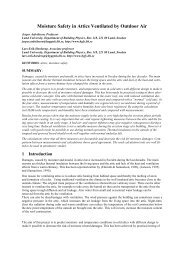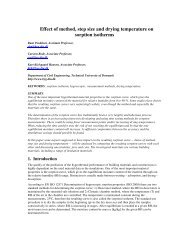Moisture and Mould Damage in Norwegian Houses
Moisture and Mould Damage in Norwegian Houses
Moisture and Mould Damage in Norwegian Houses
Create successful ePaper yourself
Turn your PDF publications into a flip-book with our unique Google optimized e-Paper software.
<strong>Moisture</strong> <strong>and</strong> <strong>Mould</strong> <strong>Damage</strong> <strong>in</strong> <strong>Norwegian</strong> <strong>Houses</strong><br />
Jonas Holme, C<strong>and</strong> Scient, Research Scientist, PhD-fellow,<br />
SINTEF Build<strong>in</strong>g <strong>and</strong> Infrastructure, Norway;<br />
jonas.holme@s<strong>in</strong>tef.no <strong>and</strong> www.s<strong>in</strong>tef.no/byggforsk<br />
Stig Gev<strong>in</strong>g, Dr.<strong>in</strong>g., Senior Scientist,<br />
SINTEF Build<strong>in</strong>g <strong>and</strong> Infrastructure, Norway;<br />
stig.gev<strong>in</strong>g@s<strong>in</strong>tef.no <strong>and</strong> www.s<strong>in</strong>tef.no/byggforsk<br />
Jon A. Jenssen, M. Sc,<br />
Trondheim Municipality, Norway<br />
jon-<strong>and</strong>reas.jenssen@trondheim.kommune.no<br />
KEYWORDS: <strong>Moisture</strong> <strong>in</strong>dicators, moisture supply, mould growth, build<strong>in</strong>g characteristics<br />
SUMMARY:<br />
Several studies have demonstrated associations between liv<strong>in</strong>g <strong>in</strong> “damp” build<strong>in</strong>gs <strong>and</strong> health effects such as<br />
respiratory symptoms, asthma <strong>and</strong> allergy. There is only limited knowledge about which agents <strong>in</strong> <strong>in</strong>door air <strong>and</strong><br />
what levels of exposure that causes the health effects. One possible agent is mould. Because of this there is a<br />
strong need for underst<strong>and</strong><strong>in</strong>g the associations between build<strong>in</strong>g characteristics <strong>and</strong> mould growth.<br />
The survey “Prevetion of atopy among children <strong>in</strong> Trondheim” <strong>in</strong>cludes both self-reported <strong>in</strong>formation about<br />
hous<strong>in</strong>g, <strong>and</strong> <strong>in</strong>spections <strong>and</strong> measurements from 205 homes. The study <strong>in</strong>cludes registered build<strong>in</strong>g<br />
characteristics such as construction, <strong>in</strong>stallations systems <strong>and</strong> moisture problems. Measurements <strong>in</strong>clude<br />
temperature, relative humidity <strong>and</strong> mould spores <strong>in</strong> the <strong>in</strong>door air. The measurements were made <strong>in</strong> bedrooms,<br />
liv<strong>in</strong>g rooms, bathrooms, basements/cellars <strong>and</strong> outdoor air.<br />
50 percent of the houses had one or more <strong>in</strong>dicator of a visible mould problem. In 42 % of the houses with no<br />
reported moisture problem, the <strong>in</strong>spector found an <strong>in</strong>dicator of a problem. Look<strong>in</strong>g at the moisture supply there<br />
were som higher values <strong>in</strong> rooms with a visible moisture <strong>in</strong>dicator <strong>and</strong> <strong>in</strong> rooms with registered mould growth<br />
compared to rooms with no <strong>in</strong>dications or mould. Type of ventilation, foundation <strong>and</strong> build<strong>in</strong>g period, have an<br />
<strong>in</strong>fluence on the precent share of houses with one or more <strong>in</strong>dicator of a visible moisture problem or regisrered<br />
mould growth.<br />
1. Introduction<br />
Dampness <strong>and</strong> other excessive moisture accumulation <strong>in</strong> build<strong>in</strong>gs are closely connected to observations of<br />
mould, mildew, or other microbial growth. The behaviour of moisture <strong>and</strong> air movements can be characterized<br />
by physical parameters, but the biological processes take place accord<strong>in</strong>g to a complicated network of regulat<strong>in</strong>g<br />
factors. Several phenomena make up the microbial ecology of an <strong>in</strong>door environment (IOM 2004).<br />
Several studies have exam<strong>in</strong>ed the aspects of moisture that are associated with biological contam<strong>in</strong>ation; these<br />
<strong>in</strong>clude exhausts <strong>in</strong> kitchens <strong>and</strong> bathrooms; below grade moisture seepage; bulk water (plumb<strong>in</strong>g leaks, roof<br />
dra<strong>in</strong>age, <strong>and</strong> envelope penetration); condensation on <strong>in</strong>adequately <strong>in</strong>sulated outside walls; <strong>and</strong> <strong>in</strong>appropriately<br />
sized cool<strong>in</strong>g coils (i.e. <strong>in</strong>correct latent heat ratio) (Spengler et al. 1994, Trechsel 1994, Dales et al. 1997). In<br />
many of the epidemiologic studies show<strong>in</strong>g an association between moisture <strong>and</strong> adverse respiratory health<br />
effects or lung disease, exposure is often def<strong>in</strong>ed with both qualitative <strong>and</strong> quantitative methods (Bornehag et al.<br />
2001, Bornehag et al. 2004). Exposure assessment methods used to characterize moisture <strong>and</strong> mould <strong>in</strong>clude the<br />
follow<strong>in</strong>g: (1) physical measurements (e.g., humidity, temperature); (2) sampl<strong>in</strong>g <strong>and</strong> analysis to detect moisture<br />
related microbes <strong>and</strong>/or chemicals <strong>in</strong> air <strong>and</strong> dust; (3) visual <strong>in</strong>spections for moisture <strong>and</strong> mould (observations);<br />
or (4) self reports from <strong>in</strong>habitants <strong>and</strong> workers <strong>in</strong> questionnaires or <strong>in</strong>terviews (reports).
Reports of damp spots, water leakage or water damage, <strong>and</strong> mould or mildew from self-report questionnaires, are<br />
used as surrogate measures for the number of fungi <strong>in</strong> several published epidemiologic studies (Kilpela<strong>in</strong>en et al.<br />
2001, Pirhonen et al. 1996, Dales et al. 1991, Platt et al. 1989, Strachan 1988). Several studies have relied on<br />
home <strong>in</strong>spections by professionals (observations) for verify<strong>in</strong>g self reported moisture <strong>and</strong> mould <strong>in</strong> the home<br />
(Haver<strong>in</strong>en et al. 2001, Platt et al. 1989, Dharmage et al. 1999a, Verhoeff et al. 1994). Dharmage et al. 1999b<br />
<strong>and</strong> Garrett et al. 1998 measured the presence of fungal propagules <strong>in</strong> air <strong>and</strong> demonstrated that observed house<br />
characteristics, such as visible mould or dampness patches, have validity as measures of mould concentrations<br />
<strong>and</strong> dampness <strong>in</strong> homes. Dharmage et al. 1999b showed that higher total airborne fungal concentrations were<br />
associated with reported visible mould.<br />
Fungal exposure <strong>and</strong> its association with moisture damage <strong>in</strong> a build<strong>in</strong>g are complex <strong>and</strong> multifaceted. Many<br />
types of fungal species are reported to grow <strong>in</strong> the <strong>in</strong>door home environment (IOM 2004). One way to provide a<br />
better underst<strong>and</strong><strong>in</strong>g of the <strong>in</strong>fluence of residential characteristics (<strong>and</strong> behaviour) on fungal levels is to clarify<br />
the def<strong>in</strong>itions of “fungal levels.” Most studies use total airborne fungi concentrations or report a dom<strong>in</strong>ant type<br />
of fungi species, such as Cladosporium or Aspergillus, <strong>in</strong> their exposure assessment analyses. Li <strong>and</strong> Kendrick<br />
1995 found significantly higher airborne fungal spore counts of specific species (Aspergillus/Penicillium,<br />
Cladosporium, unidentified basidiospores, etc.) <strong>in</strong> damp residences (def<strong>in</strong>ed as homes with visible mould, water<br />
damage, or water <strong>in</strong> the basement). Fungi can grow only on a surface or <strong>in</strong> a substrate. Many conditions of the<br />
surround<strong>in</strong>g environment (e.g., relative humidity <strong>and</strong> temperature) affect fungal growth by <strong>in</strong>creas<strong>in</strong>g or<br />
decreas<strong>in</strong>g the dry<strong>in</strong>g potential of the substrate. In general, water requirements for fungi are species specific.<br />
Exposure assessments may prove more useful if a broad group of fungal species is selected accord<strong>in</strong>g to their<br />
nutrient requirements <strong>and</strong> substrate characteristics, <strong>in</strong>clud<strong>in</strong>g water availability.<br />
As studies <strong>in</strong>creas<strong>in</strong>gly support the presence of health risks associated with moisture related agents (microbes<br />
<strong>and</strong>/or chemicals), there is a strong need for underst<strong>and</strong><strong>in</strong>g fungal concentrations <strong>and</strong> physical measurements as<br />
they relate to the microenvironment (associations between build<strong>in</strong>g characteristics <strong>and</strong> mould growth).<br />
Such knowledge is important to make future prevention of mould growth <strong>in</strong> new <strong>and</strong> already exist<strong>in</strong>g houses<br />
possible. S<strong>in</strong>ce 20-30% of the exist<strong>in</strong>g build<strong>in</strong>gs are affected by moisture problems (IOM 2004) we need<br />
knowledge for measures <strong>in</strong> such build<strong>in</strong>gs, i.e. what should we do <strong>in</strong> a problem build<strong>in</strong>g, how much of the<br />
affected material should be taken away, etc. It may also be a tribute to improve the characterization of commonly<br />
used moisture/mould <strong>in</strong>dicators, such as observation of mould, odours, ventilation <strong>and</strong> reports of moisture <strong>and</strong><br />
water sources <strong>in</strong> the house.<br />
The aim of this study has been the follow<strong>in</strong>g;<br />
• Describe <strong>in</strong>dicators of visible moisture problem <strong>in</strong> build<strong>in</strong>gs observed by <strong>in</strong>spectors <strong>and</strong> compare these to<br />
self reported moisture problem.<br />
• Compare the air humidity <strong>in</strong> bedroom, liv<strong>in</strong>g room, bathroom <strong>and</strong> basement with or without one or more<br />
<strong>in</strong>dicator on a visible moisture problem <strong>and</strong> with or without registered mould growth.<br />
• Compare the <strong>in</strong>fluence of some build<strong>in</strong>g characteristics on the number of houses with one or more<br />
<strong>in</strong>dicator on a visible moisture problem or registered mould growth compared to those without any<br />
registered <strong>in</strong>dications or mould growth.<br />
2. Method<br />
The work presented <strong>in</strong> this paper is part of the study “Prevention of atopy among children <strong>in</strong> Trondheim”<br />
(Jenssen et.al., 2001). Parents of the children that were <strong>in</strong>cluded <strong>in</strong> the “Prevention of atopy”-study were asked<br />
for permission to perform <strong>in</strong>spection of their houses until enough participants had accepted. The survey <strong>in</strong>cludes<br />
both self-reported <strong>in</strong>formation about hous<strong>in</strong>g <strong>and</strong> <strong>in</strong>spections from 205 homes <strong>in</strong> Trondheim, Norway. Indoor air<br />
humidity levels <strong>and</strong> viable mould spores <strong>in</strong> the <strong>in</strong>door air have been measured <strong>in</strong> a selection of the houses. The<br />
houses were r<strong>and</strong>omly selected for each of the four follow<strong>in</strong>g build<strong>in</strong>g types; detached one family houses,<br />
semidetached two family houses, undetached (cha<strong>in</strong>ed) houses <strong>and</strong> apartment build<strong>in</strong>gs. In each house<br />
measurements were made <strong>in</strong> the children bedroom, the liv<strong>in</strong>g room, the most used bathroom <strong>and</strong><br />
basement/cellar.<br />
Six professional <strong>in</strong>spectors performed visual <strong>in</strong>spections <strong>and</strong> assessments of air humidity levels <strong>and</strong> viable<br />
mould spores <strong>in</strong> the <strong>in</strong>door air. The <strong>in</strong>spectors were bl<strong>in</strong>ded to case-control status of the children liv<strong>in</strong>g <strong>in</strong> the
homes. Dur<strong>in</strong>g these <strong>in</strong>vestigations, a checklist was followed regard<strong>in</strong>g factors such as the type of build<strong>in</strong>g,<br />
build<strong>in</strong>g construction, type of ventilation, <strong>and</strong> mould <strong>and</strong> moisture problems. The <strong>in</strong>spectors observed possible<br />
moisture problem <strong>and</strong> sources, <strong>and</strong> f<strong>in</strong>ally graded each room <strong>and</strong> the house accord<strong>in</strong>g to the follow<strong>in</strong>g “moisture<br />
condition”; “no sign of moisture”, “few” (1 or 2, small <strong>and</strong> spread symptoms on moisture), “more” (> 2<br />
symptoms, clear signs of moisture) <strong>and</strong> “unambiguous sign of moisture” (breakdown <strong>and</strong> function failure).<br />
Questions <strong>in</strong> the basel<strong>in</strong>e questionnaire (reported) regard<strong>in</strong>g signs of moisture problems <strong>in</strong> the house could be<br />
answered by “yes” or “no”. If the answer was “yes” there was a follow up question regard<strong>in</strong>g whether or not the<br />
problem had been fixed. Also this question could be answered by “yes” or “no”.<br />
Relative humidity (RH) <strong>and</strong> temperature of the <strong>in</strong>door air were measured <strong>in</strong> 86 houses. The temperature <strong>and</strong> RH<br />
were measured at 15 m<strong>in</strong>utes <strong>in</strong>terval over a period of seven days. Small logg<strong>in</strong>g units were used (T<strong>in</strong>y tag, TGU<br />
1500, Intab). The loggers were positioned away from w<strong>in</strong>dows, heat<strong>in</strong>g units, direct sunlight or outer door. The<br />
loggers were placed between 1,5 – 2,0 m above floor level. The accuracy of the loggers were ± 5 % RH <strong>and</strong> ±<br />
0,5 o C. The loggers were controlled <strong>in</strong> a climate chamber at 50% RH <strong>and</strong> 23 o C before be<strong>in</strong>g used. Hourly data<br />
for outdoor RH were retrieved from an automatic weather station located <strong>in</strong> Trondheim operated by the<br />
<strong>Norwegian</strong> Meteorological Institute. The moisture supply (∆v) was calculated on an hourly basis. The moisture<br />
supply is def<strong>in</strong>ed as the difference between <strong>in</strong>door <strong>and</strong> outdoor air water vapour content (<strong>in</strong> g/m 3 ). Mean weekly<br />
values for the moisture supply were calculated from these hourly values.<br />
In selected build<strong>in</strong>gs, samples of viable micro organisms (fungi <strong>and</strong> bacteria) were taken <strong>in</strong> the child's bedroom,<br />
liv<strong>in</strong>g room, bathroom <strong>and</strong> basement. The samples were taken approximately one meter above the floor, under<br />
normal conditions regard<strong>in</strong>g use, heat<strong>in</strong>g <strong>and</strong> ventilation <strong>in</strong> the house. Reference samples were taken outdoors.<br />
The sampler used was a Biotest St<strong>and</strong>ard RCS Sentrifugal Air Sampler (Biotest AG, Dreieich, Germany), which<br />
is a h<strong>and</strong>held, battery operated <strong>in</strong>strument that collects bioaerosols on a nutrient agar to allow direct cultur<strong>in</strong>g<br />
techniques to be used to enumerate airborne micro organisms. A fan draws air through the sieve plate caus<strong>in</strong>g<br />
airborne particles to impact on the agar plate <strong>and</strong> air is exhausted through the side of the sampler. All sampl<strong>in</strong>g<br />
equipment was calibrated before use. The samples were taken on both Tryptic Soy Agar (TSA) <strong>and</strong> Rose Bengal<br />
Agar (RBA). Sampl<strong>in</strong>g volume was set at 40 litres/m<strong>in</strong>ute <strong>in</strong> 8 m<strong>in</strong>utes for each media.<br />
Microscopical analyses at 400x <strong>and</strong> 1000x magnification <strong>in</strong> light microscope were conducted after cultivation at<br />
22 ºC for 5-7 days. Identification of fungi was <strong>in</strong> general done to the level of specie. Amount <strong>and</strong> type of mould<br />
specie detected <strong>in</strong> the respective room, was compared to the sample taken outdoor. If the sample from the <strong>in</strong>door<br />
air differed either <strong>in</strong> concentration, mould specie or both, compared to the sample taken from the outside, the<br />
room had registered mould growth.<br />
3. Results<br />
Table 1 shows the percent share of different <strong>in</strong>dicators of a moisture problem <strong>in</strong> the houses, the child’s<br />
bedrooms, liv<strong>in</strong>g rooms, bathrooms <strong>and</strong> basements. 50 % of the build<strong>in</strong>gs had one or more visible <strong>in</strong>dicator of a<br />
moisture problem. The most common <strong>in</strong>dicator was spots of moisture, swell<strong>in</strong>g or capillary attraction of water <strong>in</strong><br />
wood which appeared <strong>in</strong> 18 % of the houses. 15 percent had a leak from the ground, <strong>and</strong> 15 % showed<br />
condensation on surface other than w<strong>in</strong>dows. In the child’s bedroom 11 % of the rooms <strong>in</strong>spected had one or<br />
more visible <strong>in</strong>dicator on a moisture problem. The most dom<strong>in</strong>ant <strong>in</strong>dicator was condensation on w<strong>in</strong>dow (3%)<br />
<strong>and</strong> on surface (6%). Liv<strong>in</strong>g rooms had fewer <strong>in</strong>dicators compared to the other rooms. Only 5 % of the rooms<br />
had one or more <strong>in</strong>dicators of a moisture problem. 21 % of the bathrooms had one or more <strong>in</strong>dicator of a visible<br />
moisture problem. The dom<strong>in</strong>at<strong>in</strong>g <strong>in</strong>dicators were spots of moisture, swell<strong>in</strong>g <strong>and</strong> capillary attraction of water<br />
(5 %) <strong>and</strong> condensation on w<strong>in</strong>dow (5%) <strong>and</strong> surface (9%). 65 % of the basements had one or more <strong>in</strong>dicator of<br />
a visible moisture problem. The most common <strong>in</strong>dicator was not surpris<strong>in</strong>gly, leakages from the ground (52 %).<br />
The <strong>in</strong>spectors found that <strong>in</strong> the houses with no reported moisture problem ever, 42 % had one or more <strong>in</strong>dicator<br />
on a visible moisture problem (Table 2). In the houses where a reported moisture problem had been repaired, the<br />
<strong>in</strong>spectors found an <strong>in</strong>dication <strong>in</strong> 53 % of them. In the houses where a moisture problem never had been repaired,<br />
the percent share with one or more <strong>in</strong>dicator on a visible moisture problem was 62 %. The percent share varies<br />
between the different types of rooms. The basements had a high percent share observed moisture <strong>in</strong>dicator <strong>in</strong><br />
each of the reported categories, all over 63 %.<br />
Table 3 shows the mean moisture supply <strong>in</strong> child’s bedroom, liv<strong>in</strong>g room, bathroom <strong>and</strong> basement, with or<br />
without <strong>in</strong>dicators of a visible moisture problem <strong>and</strong> with or without registered mould growth. Bathrooms had
the highest moisture supply with a mean on 3.16 g/m 3 . Liv<strong>in</strong>g rooms had a mean on 1.9 g/m 3 . Child’s bedrooms<br />
<strong>and</strong> basements had a mean around 1.5 g/m 3 . There was a higher moisture supply <strong>in</strong> child’s bedrooms, liv<strong>in</strong>g<br />
rooms <strong>and</strong> bathrooms with one or more <strong>in</strong>dicator on a visible moist problem compared to those with no observed<br />
<strong>in</strong>dicator. In the basement however the moisture supply was higher <strong>in</strong> those with no <strong>in</strong>dicator. Child’s bedrooms<br />
<strong>and</strong> bathrooms had a higher moisture supply compared to those with no registered mould growth. In liv<strong>in</strong>g<br />
rooms <strong>and</strong> basements the rooms with no registered growth had a higher moisture supply compared to those with<br />
a registered growth<br />
Table 4 gives the percent share of houses <strong>and</strong> rooms with (yes) or without (no) mould growth <strong>in</strong> each category of<br />
the categorized (by <strong>in</strong>spectors) moisture condition <strong>in</strong> all houses, child’s bedrooms, liv<strong>in</strong>g rooms, bathrooms <strong>and</strong><br />
basements. The percent share houses with registered mould growth <strong>in</strong> one or more rooms are higher <strong>in</strong> the two<br />
worse categories (“more” <strong>and</strong> “unambiguous”) regard<strong>in</strong>g the <strong>in</strong>spector’s classification of the moisture condition<br />
of the whole house. The situation is the same for bathrooms.<br />
Table 5 gives an impression on how different build<strong>in</strong>g characteristics <strong>in</strong>fluence on the percent share of houses<br />
with or without one or more <strong>in</strong>dicator on a moisture problem, <strong>and</strong> with or without registered mould growth.<br />
The percent share with “no ventilation” <strong>and</strong> “natural ventilation” is higher <strong>in</strong> the groups of houses with one or<br />
more moisture <strong>in</strong>dicator <strong>and</strong> the houses with registered mould growth, compared to the houses with no <strong>in</strong>dicator<br />
or no registered mould growth. The difference is significant (p
TABLE 2: The percent share with one or more observed <strong>in</strong>dicator of a visible moisture problem <strong>in</strong> houses <strong>and</strong><br />
different type of rooms <strong>in</strong> each category of reported moisture problem<br />
Never reported a moisture problem (n<br />
=107)<br />
Reported moisture problem are repaired<br />
(n = 32)<br />
Reported moisture problem are not<br />
repaired (n =66)<br />
Whole<br />
build<strong>in</strong>g<br />
(205)<br />
Child’s<br />
bedroom<br />
(205)<br />
Liv<strong>in</strong>g<br />
room (205)<br />
Bathroom<br />
(205)<br />
Basement<br />
(46)<br />
42 8 5 18 67<br />
53 16 6 25 63<br />
62 14 6 24 65<br />
TABLE 3: <strong>Moisture</strong> supply <strong>in</strong> child’s bedroom, liv<strong>in</strong>g room, bathroom <strong>and</strong> basement with or without <strong>in</strong>dicators<br />
of a visible moisture problem, <strong>and</strong> with or without mould growth.<br />
Valid N Mean SD Percentile 75<br />
Child’s bedroom 87 1.5 1 1.97<br />
Liv<strong>in</strong>g room 87 1.9 0.95 2.54<br />
Bathroom 86 3.16 1.32 3.94<br />
Basement 85 1.37 1.08 1.98<br />
One or more <strong>in</strong>dicator on a visible moisture problem<br />
Child’s bedroom No 79 1.47 1.0 1.97<br />
Yes 8 1.82 1.05 2.37<br />
Liv<strong>in</strong>g room No 78 1.87 0.97 2.51<br />
Yes 9 2.20 0.75 3.0<br />
Bathroom No 69 3.12 1.3 3.94<br />
Yes 17 3.31 1.45 4.39<br />
Basement No 67 1.44 1.13 2.17<br />
Registered mould growth<br />
Yes 18 1.13 0.87 1.83<br />
Child’s bedroom No 44 1.39 1.06 1.95<br />
Yes 6 1.55 0.91 2.40<br />
Liv<strong>in</strong>g room No 40 1.87 1.05 2.53<br />
Yes 10 1.42 0.67 1.72<br />
Bathroom No 42 3.07 1.49 3.93<br />
Yes 7 3.17 0.74 3.63<br />
Basement No 10 1.2 0.74 1.8<br />
Yes 2 0.87 2.02 -
TABLE 4: The percent share of houses <strong>and</strong> rooms with (yes) or without (no) mould growth <strong>in</strong> each category of<br />
the “<strong>Moisture</strong> condition” <strong>in</strong> all houses, child’s bedrooms, liv<strong>in</strong>grooms, bathrooms <strong>and</strong> basements / cellars.<br />
All houses* Child’s<br />
bedroom<br />
Yes<br />
(43)<br />
No<br />
(96)<br />
Yes<br />
(18)<br />
No<br />
(121)<br />
Liv<strong>in</strong>groom Bathroom* Basement /<br />
cellar<br />
Yes<br />
(27)<br />
No<br />
(112)<br />
Yes<br />
(19)<br />
No<br />
(120)<br />
No symptom 25.6 43.8 77.8 90.9 92.6 94.6 52.6 63.3 22.2 19.0<br />
Few (1 or 2) small <strong>and</strong><br />
spread symptoms<br />
More (>2) <strong>and</strong> good visible<br />
signs<br />
27.9 32.3 22.2 7.4 7.4 4.5 21.1 24.2 33.3<br />
41.9 24.0 1.7 0.9 21.1 12.5 66.7 47.6<br />
Unambiguous sign 4.7 5.3 11.1<br />
* Significant difference between the to groups (“yes” <strong>and</strong> “no”) (p< 0.05)<br />
TABLE 5: Different build<strong>in</strong>g characteristics <strong>in</strong>fluence on the percent share of houses with or without one or<br />
more <strong>in</strong>dicator on a moisture problem, <strong>and</strong> with or without registered mould growth.<br />
Ownership<br />
Yes<br />
(9)<br />
No<br />
(21)<br />
One or more <strong>in</strong>dicator on a visible moisture problem Registered mould growth<br />
No Yes No Yes<br />
Owner 64.3 60.6 59.1 64.3<br />
Owner, hous<strong>in</strong>g cooperative 31.6 28.3 32.3 31.0<br />
Tenant 4.1 11.1 8.6 4.8<br />
No ventilation 2.9 11.8 5.3 11.6<br />
Natural ventilation 39.2 52.9 44.2 58.1<br />
Mechanical ventilation 49.0 29.4 41.1 27.9<br />
Balanced ventilation 8.8 5.9 9.5 2.3<br />
Basement/cellar 13.7 36.3 21.9 34.9<br />
Crawl space 2.0 3.9 2.1 2.3<br />
Slab on ground 40.2 42.2 41.7 30.2<br />
Other apartment 43.1 16.7 33.3 30.2<br />
Other 1.0 1.0 1.0 2.3<br />
→ 1960 30.2 43.9 34.1 47.2<br />
1961 to 1983 34.9 30.5 32.9 33.3<br />
1984 → 34.9 25.6 32.9 19.4<br />
Detached one family houses 26.5 36.3 34.4 26.2<br />
Semidetached family houses 28.4 23.5 25.0 26.2<br />
Undetached (cha<strong>in</strong>ed) houses 9.8 17.6 12.5 19.0<br />
Apartment build<strong>in</strong>gs 32.4 20.6 27.1 23.8<br />
Other house 2.9 2.0 1.0 4.8
4. Discussion<br />
In this study 50 % of the houses had one or more <strong>in</strong>dicator of a visible moisture problem. The prevalence is a bit<br />
high compared to other studies. The damp <strong>in</strong>door space <strong>and</strong> health report (IOM 2004) have summarized<br />
published data on the prevalence of signs of moisture <strong>in</strong> build<strong>in</strong>gs. The reported prevalence of signs of moisture<br />
ranged from 1 % to 85 %. In most datasets, at least 20 % of the build<strong>in</strong>gs have one or more sign of a moisture<br />
problem.<br />
In this study child’s bedroom <strong>and</strong> liv<strong>in</strong>g room have a relatively low share of <strong>in</strong>dicators of a moisture problem.<br />
This is not surpris<strong>in</strong>gly because these two rooms have few elements that can cause a water damage compared to<br />
i.e. bathroom <strong>and</strong> basements.<br />
In 42 % of the houses with no reported sign of a moisture problem ever, the <strong>in</strong>spectors found one or more<br />
<strong>in</strong>dicator of a moisture problem. Nevala<strong>in</strong>en et al. (1998) reported similar results, suggest<strong>in</strong>g that the explanation<br />
was a result of a tra<strong>in</strong>ed eye <strong>and</strong> of knowledge of what represents a critical problem. There is a tendency <strong>in</strong> our<br />
study <strong>in</strong> a higher percent share of houses with one ore more <strong>in</strong>dicator of a moisture problem among the houses<br />
where the <strong>in</strong>habitants themselves once have reported a moisture problem compared to those who never have<br />
reported a problem.<br />
Rooms with one or more <strong>in</strong>dicator on a visible moist problem have a higher moisture supply compared to those<br />
with no <strong>in</strong>dicators (this does not <strong>in</strong>clude basement/cellars). These f<strong>in</strong>d<strong>in</strong>gs are not surpris<strong>in</strong>gly, taken <strong>in</strong>to<br />
account that the moisture <strong>in</strong>dicators often br<strong>in</strong>gs water <strong>in</strong>to the environment. Regard<strong>in</strong>g rooms with or without<br />
registered growth we should expect the same result, but <strong>in</strong> this study the differences is even smaller <strong>and</strong> appears<br />
only <strong>in</strong> child’s bedroom <strong>and</strong> bathroom. This is strange because water is the most important limit<strong>in</strong>g factor fore<br />
mould growth (IOM 2004).<br />
Indoor moisture is l<strong>in</strong>ked to some build<strong>in</strong>g characteristics. In this study there is an association between a higher<br />
percent share of houses with one or more moisture <strong>in</strong>dicators <strong>and</strong> type of ventilation, type of foundation <strong>and</strong><br />
build<strong>in</strong>g period. Reported dampness has been associated with age of the build<strong>in</strong>g, lack of central heat<strong>in</strong>g,<br />
humidifiers <strong>and</strong> pets (Sprengler et al., 1994; Tariq et al., 1996)). Older build<strong>in</strong>g tend to be colder <strong>and</strong> (Hunt <strong>and</strong><br />
Gidman, 1982), <strong>and</strong> therefore to have higher RH. Microbiological has also been associated with build<strong>in</strong>g<br />
characteristics. Measures of microbial contam<strong>in</strong>ation have been found to be positively correlated with <strong>in</strong>door<br />
temperature <strong>and</strong> humidity, age <strong>and</strong> size of build<strong>in</strong>gs, use of wood stoves <strong>and</strong> fireplaces, absence of mechanical<br />
ventilation (IOM 2004). In this study there were more houses with registered mould growth <strong>in</strong> houses with no or<br />
natural ventilation compared to houses with mechanical ventilation, <strong>and</strong> <strong>in</strong> houses with basement cellar<br />
compared to those with slab on ground. There was also an association <strong>in</strong> more registered mould <strong>in</strong> older houses<br />
compared to newer ones.<br />
5. Acknowledgements<br />
This paper has been written with<strong>in</strong> the ongo<strong>in</strong>g SINTEF strategic <strong>in</strong>stitute projects “Climate 2000 – Weather<br />
Protection <strong>in</strong> the Construction Process”. The authors gratefully acknowledge the Research Council of Norway.
6. References<br />
Bornehag, C.G. et al. (2001) Dampness <strong>in</strong> build<strong>in</strong>gs <strong>and</strong> health. Nordic <strong>in</strong>terdiscipl<strong>in</strong>ary review of the scientific<br />
evidence on associations between exposure to "dampness" <strong>in</strong> build<strong>in</strong>gs <strong>and</strong> health effects<br />
(NORDDAMP), Indoor Air, 11, 72-86.<br />
Bornehag, C.G. et al.. (2004) "Dampness <strong>in</strong> build<strong>in</strong>gs as a risk factor for health effects, EUROEXPO: a<br />
multidiscipl<strong>in</strong>ary review of the literature (1998-2000) on dampness <strong>and</strong> mite exposure <strong>in</strong> build<strong>in</strong>gs <strong>and</strong><br />
health effects", Indoor Air, 14, 243-257.<br />
Dales R.E., Burnett R. <strong>and</strong> Zwanenburg H. (1991). Adverse health effects among adults exposed to home<br />
dampness <strong>and</strong> molds, American Review Of Respiratory Disease, Vol 143.3, p.505-09.<br />
Dales R.E., Miller D. <strong>and</strong> McMullen E. (1997). Indoor air quality <strong>and</strong> health: validity <strong>and</strong> determ<strong>in</strong>ants of<br />
reported home dampness <strong>and</strong> moulds, International Journal of Epidemiology, Vol 26.1, p.120-25.<br />
Dharmage S. et al. (1999a). A reliable <strong>and</strong> valid home visit report for studies of asthma <strong>in</strong> young adults, Indoor<br />
Air, Vol 9.3, p.188-92.<br />
Dharmage S. et al. (1999b). Prevalence <strong>and</strong> residential determ<strong>in</strong>ants of fungi with<strong>in</strong> homes <strong>in</strong> Melbourne,<br />
Australia, Cl<strong>in</strong>ical <strong>and</strong> Experimental Allergy, Vol 29.11, p.1481-89.<br />
Garrett M.H. et al. (1998). Indoor airborne fungal spores, house dampness <strong>and</strong> associations with environmental<br />
factors <strong>and</strong> respiratory health <strong>in</strong> children, Cl<strong>in</strong>ical <strong>and</strong> Experimental Allergy, Vol 28.4, p.459-67.<br />
Haver<strong>in</strong>en U. et al. (2001). Comparison of two-level <strong>and</strong> three-level classifications of moisture-damaged<br />
dwell<strong>in</strong>gs <strong>in</strong> relation to health effects, Indoor Air, Vol 11.3, p.192-99.<br />
Hunt D.R.G <strong>and</strong> Gidman A.M.I.A. (1982). A national field survey of house temperatures. Build<strong>in</strong>g <strong>and</strong><br />
Environment 17(2):102-124<br />
IOM. (2004). Damp Indoor Spaces <strong>and</strong> Health, Institute of Medic<strong>in</strong>e of the National Academies.<br />
Jenssen J.A. et.al. (2001). Barneallergistudien i Trondheim (Children allergy study <strong>in</strong> Trondheim: In<br />
<strong>Norwegian</strong>), Allergi i praksis, Vol 4, p.34-38.<br />
Kilpela<strong>in</strong>en M. et al. (2001). Home dampness, current allergic diseases, <strong>and</strong> respiratory <strong>in</strong>fections among young<br />
adults, Thorax, Vol 56.6, p.462-67.<br />
Li D.W. <strong>and</strong> Kendrick B. (1995). Indoor aeromycota <strong>in</strong> relation to residential characteristics <strong>and</strong> allergic<br />
symptoms, Mycopathologia, Vol 131.3, p.149-57.<br />
Nevala<strong>in</strong>en A. et al. (1998). Prevalence of moisture problems <strong>in</strong> F<strong>in</strong>ish houses. Indoor Air (Supplement 4):45-49<br />
Pirhonen I. et al. (1996). Home dampness, moulds <strong>and</strong> their <strong>in</strong>fluence on respiratory <strong>in</strong>fections <strong>and</strong> symptoms <strong>in</strong><br />
adults <strong>in</strong> F<strong>in</strong>l<strong>and</strong>, European Respiratory Journal, Vol 9.12, p.2618-22.<br />
Platt S.D. et al. (1989). Damp hous<strong>in</strong>g, mould growth, <strong>and</strong> symptomatic health state, British Medical Journal,<br />
Vol 298.6689, p.1673-78.<br />
Spengler J. et al. (1994). Respiratory Symptoms <strong>and</strong> Hous<strong>in</strong>g Characteristics, Indoor Air, Vol 4.2 , p.72-82.<br />
Strachan D.P. (1988). Damp hous<strong>in</strong>g <strong>and</strong> childhood asthma: validation of report<strong>in</strong>g of symptoms, British<br />
Medical Journal, Vol 297.6658, p.1223-26.<br />
Tariq S.M et al. (1996). Senzitation to Alternaria <strong>and</strong> Cladosporium by the age of 4 years. Cl<strong>in</strong>ical <strong>and</strong><br />
Experimental Allergy 26:794-798<br />
Trechsel H.R. (1994). <strong>Moisture</strong> Control <strong>in</strong> Build<strong>in</strong>gs, American Society for Test<strong>in</strong>g <strong>and</strong> Materials, Philadelphia.<br />
Verhoeff A. P. et al. (1994). Fungal Propagules In-House Dust .2. Relation with Residential Characteristics <strong>and</strong><br />
Respiratory Symptoms, Allergy, Vol 49.7, p.540-47.


